Kids These Days Keep Asking For “Positive Representation”
Hey all! Happy Friday! Today, you will be reading about my favorite horror movie. Yes, you heard that right, my favorite horror movie ever. Now, I want to preface this by saying that this is not, by most reasonable standards and metrics, a good movie. It’s not one of the ‘big five’ eighties slashers that spawned franchises. It’s not a modern masterpiece like Hereditary or Sinners. It is instead, a shaky cult classic summer camp slasher that came out in 1983 and quickly became the ultimate dare movie at a sleepover, and has, through some miracle of criticism, landed itself a cool 81% on Rotten Tomatoes. If you’ve guessed it by now, congratulations! If you haven’t, my favorite horror movie, one I will watch anytime for any reason, is the one and only Sleepaway Camp.
But before we get into the meat and potatoes of this analysis, there are a couple charities for this post, because boy howdy is it scary out there. First, Planned Parenthood recently lost its federal funding. And as scary as that is, it’s important to remember that that’s not all the funding they had, and that donations really do help. Planned Parenthood offers vital healthcare to everyone that needs it, so please donate if you can. (https://www.weareplannedparenthood.org/onlineactions/2U7UN1iNhESWUfDs4gDPNg2?sourceid=1000063&refwidget=Historic_Donate_Button&_gl=1*11u51rs*_gcl_au*MTgxMzk4ODQwOS4xNzUyMTY0NDUz*_ga*MTQ0MTczMjQxOS4xNzUyMTY0NDUz*_ga_ENXC8KHJL8*czE3NTIxNjQ0NTMkbzEkZzAkdDE3NTIxNjQ0NTUkajU4JGwwJGgyMTMzNjg2ODg1) Second, because this movie deals with a lot of difficult topics (Does it do so tastefully? No, but it’s the thought that counts.). And while there are very many, I would like to draw your attention to one in particular: The Trans Lifeline. Sleepaway Camp does (however strangely) deal with trans issues, and, as most of you know, trans rights are very much under attack right now. The Trans Lifeline provides support for anyone who needs it, which is especially important now. Again, please help if you can. (https://translifeline.org/?campaign=488252).
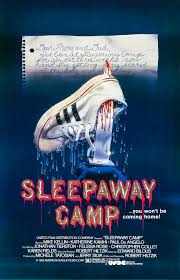
There’s a lot to be said about Sleepaway Camp, as there is with any other horror movie. It says a lot about the time it came out in, widespread cultural fears and attitudes, etc. It is also an early piece of representation of the summer camp slasher trend/subgenre, as well as an early example of camp in horror. For a kinda trashy little cult classic of a slasher, there’s a lot there. So let’s get into it.
So, right off the bat, the movie opens with a tragedy. Two men on a speedboat with their children, one boy and one girl, get into a crash caused by teenagers at a local camp that leaves both men and their son dead, with only their daughter, Angela, remaining. Ten years later, Angela and her cousin Ricky are sent away to that same summer camp. Now, here is where the first moment of camp is: Aunt Martha. Angela’s aunt and Ricky’s mother, Aunt Martha has big, wide eyes, eccentric clothing, flamboyant hand gestures, and a strange, detached way of speaking. She is forgetful and flighty, clearly not someone who’s the most fit to raise two children, one of whom is severely traumatized. But she’s raised them, and so she sends them to camp.
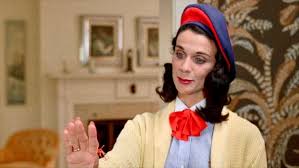
When the kids arrive at camp, Angela hangs shyly around Ricky, who tries to connect with his camp girlfriend from last year, who has physically matured considerably over the time they’ve been away. But said girlfriend - Judy - wants nothing to do with him, and hangs out with the older boys instead. A few days later, Angela has a run in with the cook, who turns out to be a pedophile. Ricky saves her in time, and they run back to the mess hall. Later that day, an industrial pot of boiling water falls on Cook, and he is taken out of camp to the hospital.
And so the killings begin.
Cook doesn’t technically die, but we, the audience, are left to assume that he either died in, or en route to, the hospital, because he never comes back. The second person to die is Kenny, an older boy who drowns in the lake after bullying Angela with his friends. Next is Billy, a friend of Kenny’s, who gets a bees’ nest dropped on him in a bathroom stall that is barricaded with a broomstick. Then Meg, a counselor and friend of Judy’s both of whom bully Angela throughout, is stabbed in the back through the wall of a shower stall. Judy is smothered with a pillow after (offscreen) having a hot curling iron shoved into her vagina. Four young campers who convinced their counselor to go out in their sleeping bags are chopped to death in their sleeping bags with a small hatchet. Mel, the head counselor, is shot through the neck with an arrow from the archery range. And finally, poor Paul, Angela’s new boyfriend, is decapitated on the beach.
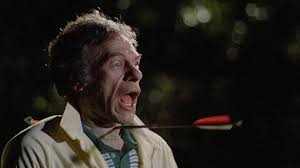
Most of these are, as I’m sure you’ve noticed, not normal slasher kills. They’re over the top, insane, and impractical. Campy, if you will. Now, I’ve said it before, and I’ll say it again, the patterns in early slasher movies have a pretty simple throughline that begins with the Tate/LaBianca murders, continues through the AIDS epidemic, and is revived through satire with Scream. Early slashers, like Texas Chain Saw, Friday the 13th, and Halloween are all Manson slashers, because they happened before the AIDS epidemic began. They’re centered on teenagers, and men with simple weapons stalking them and their friends through otherwise idyllic pieces of America. This idea translated very well to the AIDS epidemic, when copious amounts of blood and sex began to have a different meaning than they used to to most of America. This is where you get Freddy Krueger, Pinhead, the Deadites, oh…and Angela Baker.
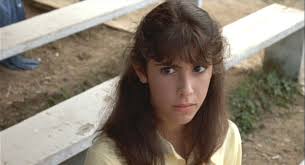
Culturally, Sleepaway Camp is the perfect example of an early eighties slasher, specifically. It still has some elements of late-seventies Manson slashers – a fixation on teens and children, twisted family dynamics, and relatively simple, not supernatural weapons – as well as other elements that perfectly foreshadow what was to come in the slasher genre, like higher camp kills, unexpected killers, and queer or queer-coded villains. I think I’ve mentioned this before, but most slashers from the eighties and nineties are quer-coded in some way. Freddy Krueger and Pinhead are the earliest examples, but the Santa Carla vampires and Buffalo Bill are not to be slept on, either. The reason for this is, as it tends to be with eighties horror, the AIDS epidemic. Huge, widespread fears about queer people, especially queer men, swept America, leading to increased hate crimes, and cartoonish, campy villains in all kinds of media meant to mimic the men who were dying in droves across the nation. And in the early years of this disaster, before Freddy, before Pinhead, and long before Buffalo Bill, you have Angela Baker.
In one of the most infamous twist endings in horror cinema (or all of cinema, for that matter) two counselors at Camp Arawak who have gone out looking for their missing campers stumble upon Angela sitting, naked, with her back to them on the beach. As they approach, calling her name, she turns around, stands up, and snarls. Blood covers her chest. Paul’s head falls from her lap. And then, a flashback. Aunt Martha talks to a child standing on the stairs of her home, having recently lost both parents. She talks about how she always wanted a little girl, and how lovely it will be to have one now…isn’t that right, Peter? With a dramatic flash of light the camera pans to reveal that this is, in fact, a little boy. Angela didn’t survive the crash. Peter did, and then Aunt Martha made him become Angela. As you do when you have to take in your brother’s orphaned child.
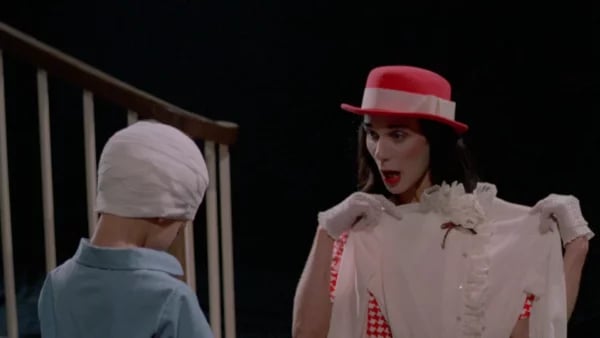
So there’s an awful lot to unpack there. First, I want to make it clear that Angela is not, by any means, the first cross-dressing killer. That honor goes to our good friend Norman/Norma Bates from Psycho. And Leatherface after him. And, it could be argued, the Deadites after that. Angela is right in the middle of a long line of cross-dressing killers, that continued to include Buffalo Bill, Art the Clown, Longlegs, Captain Spaulding, and many more. With varying degrees of tact from their creators over time (Oz Perkins vehemently denied all accusations of transphobia, like a boss, while Damien Leone refuses to critically interpret his own franchise. To each their own.), the cross-dressing killer is a pretty well documented trope at this point in time. But Angela stands out stark among all of those. Unlike Buffalo Bill or any of the others, she is actually canonized as transgender, choosing to live her life as a woman as the franchise continues. While Sleepaway Camp doesn’t handle her transition with any kind of care at all, at worst conflating being transgender with child abuse and trauma, it also doesn’t handle anything with any kind of care at all. It kills children. It shoves curling irons up pre-teens’ vaginas. It does. Not. Care.
The kind of camp that is present in Sleepaway Camp is aggressively shocking and scandalous. Who would kill someone like that? A psychopath, that’s who. And who are the psychopaths right now? The drag queens, the cross-dressers, the gays, and the queers. It’s really pretty much that simple. But in this subconscious fearmongering there is also what is often referred to as the ‘gay male gaze’ present in the cinematography and directing. The focus on female anatomy through out the movie is basically zero. Boys’ bodies, however, are all over the place. There’s crotch grabs, skinny dipping, face-in-butt pranks, and male camp counselors running around in crop tops and short shorts for no reason. Playing baseball like that is asking for a skinned knee, but they do it anyway because it’s 1983. And while you might be reading this and thinking “but isn’t that the female gaze?” I feel obliged to tell you first, that this movie was directed by a man by the name of Robert Hiltzik, and second, that that is not what the female gaze looks like. The female gaze tends very non-threatening, sexy professors, priests, farmers, etc. Men under the gay male gaze in cinema are generally pretty intimidating, athletic, and nude. Women put their sexy men in uniforms, sweaters, and such. Men do not. The gay male gaze also doesn’t pay much attention to the women in the movie, like in Sleepaway Camp. The only other girls that are focused on that aren’t Angela are Meg and Judy, gossiping bullies extraordinaire. Their snappy quips and one-liners only add to the camp aspects of this movie, and its inherent queerness, as well.
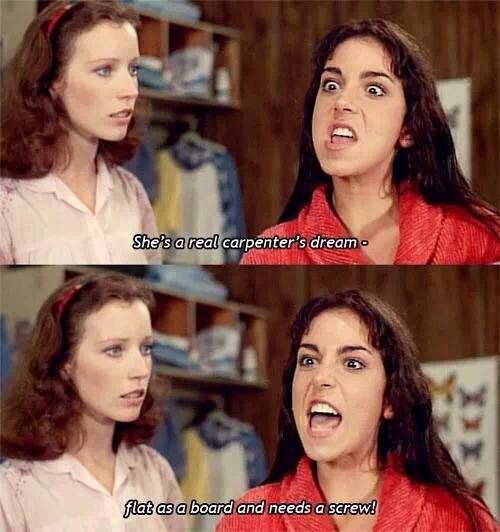
At this point, you may be wondering whether I’m maybe giving this movie too much credit, reading into it too much. And I might be. But keep in mind that all of it was there to be read. Sure, most of what happens in Sleepaway Camp happens for shock value and shock value alone, there’s no denying that. But all that other stuff - the “gay male gaze”, Angela’s transness, where this movie exists in time and culture, and what that all means in context - inherently has larger meaning to it outside the bounds of those 84 bloody minutes. It’s a subconcious thing that is present in every movie, book, TV show, or what have you out there. No matter what, your story is influenced by your own beliefs about and views of the world, which are impacted by the time and place you are living in when you make it, as well as the time and place you were raised in. I discussed this phenomenon more in my post about Damien Leone and the Terrifier franchise, but that’s about the long and the short of it. The creator might not have left all that there to be read into on purpose, but damned if it isn’t sitting out on that page.
All this to say that the question of whether or not Sleepaway Camp is “positive representation” is pointless nearly to incoherence. Because that’s not what it’s there for. Strangely enough, if not for all the murders, Sleepaway Camp has potential to be a very sweet coming-of-age summer camp story. Angela comes into her own at camp, making friends with a counselor, getting a boyfriend, and learning to speak up for herself. Mostly by killing the people who are nasty to her, but you know what I mean. It’s a ridiculous, insane, campy movie that is so incredibly of its time that it could be used as a historical reference point in terms of the long-term and immediate effects of historical events such as the Tate/LaBianca murders and the AIDS epidemic on the larger cultural zeitgeist. And should be, I think. It’s a lot more fun than some of the others.
So, as the credits roll, we stare at Angela’s face, mouth wide in a silent scream, eyes looking off to the side as if to avoid contact, blood on her neck, falling onto her chest. Her hair is huge, her bangs kind of cute. She is angry, so angry that she killed all the people who hurt her. All the people like the ones who killed her parents all those years ago. We know what we’re not seeing, just out of frame, what we saw between her legs as she stood and growled at those counselors, her boyfriend’s head resting in the sand next to her. But we know what we are seeing, too. We’re seeing Angela Baker. We’re seeing Angela, and she is beautiful. She is murderous, yes, but she is marvelous, too. And in this moment, as white text scrolls across her face, slowly blurring out into a sickly green background, we are her and she is us.
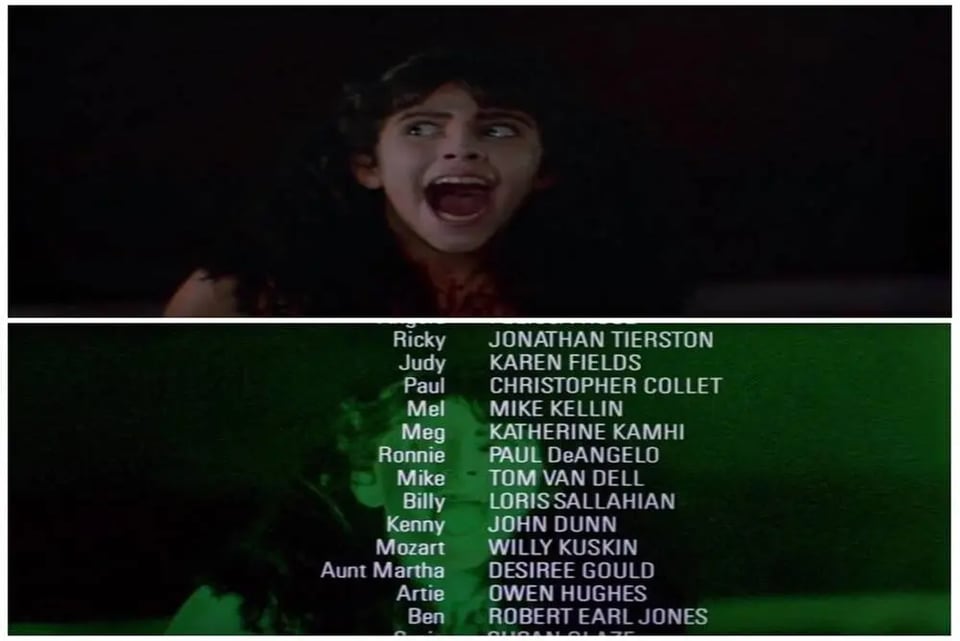
Thanks for reading, all! I hope you enjoyed reading this as much as I enjoyed writing it. I love Sleepaway Camp so much if you couldn’t tell, and hope this post convinces at least one more person to watch it. It’s a really fun time, and there’s a lot under its grainy surface. It’s free on Tubi and PlutoTV (with ads) and without ads on Kanopy, which is free with a library card, which every single person reading this should have. Next post will be out on Friday the 25th, where we will be continuing splat summer in spectacular fashion. Hope to see y’all there! Happy reading and stay spooky! 🚤🐝🏳️⚧️🩸